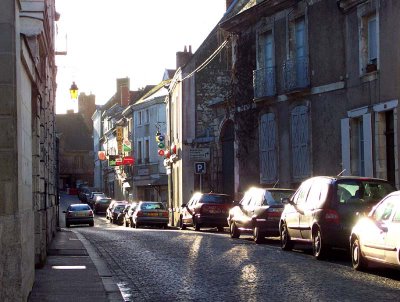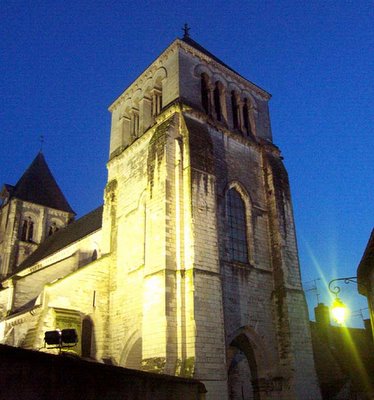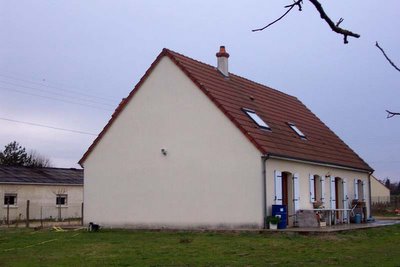The nature of blogs is that you read forward, not backward. The problem is that this is the fourth in a series of articles. If you want to read them in order, use these links. Then click Next at the bottom of each article to jump to the next one in the series.
We drove back to the gîte after our first day of house-hunting wondering what Saint-Aignan would be like. If houses were less expensive there, as Bourdais seemed to me to be implying, maybe it wasn’t a desirable location. “Maybe it’s some kind of ville nouvelle, all Soviet-style 1960s architecture, big apartment blocks. Maybe it’s an industrial center. Maybe it’s a ghost town,” I told Walt. Always the optimist, I am. My vision of France was skewed by my familiarity with Paris and its banlieues.
Back at the gîte we got out the map and studied it. It was true that Saint-Aignan-sur-Cher was just ten miles upriver from Montrichard, on the opposite bank. There was nothing near it that we were familiar with, except Valençay, where there is a famous château.
We had lunch in Valençay in October 2000 and enjoyed it. The restaurant was very old-fashioned and the other customers, especially one very bourgeois-looking French woman who was seated facing us, stared at us with cold eyes as we sat waiting to be brought menus. We felt like aliens and wondered what she was looking at. We don’t know if it was because we were two men, because we looked American, or because we weren’t dressed properly. Or maybe she wasn’t looking at us at all. We had a good lunch anyway, with a bottle of the local Valençay VDQS red wine.
Would Saint-Aignan be as old-fashioned as Valençay had seemed? That would be fine with me. I can stare at foreigners with the best of them -- or even at French people all dressed up in their Sunday best. I kind of liked the idea. We decided that since we had Tuesday morning free, the smart thing to do would be to drive over to Saint-Aignan and have a look around. If we hated it, we could tell Bourdais at our 2:30 meeting that we’d rather see houses closer to Montrichard — which didn’t seem old-fashioned and formal but bustling and friendly — or closer to Amboise, which is where we had wanted to start anyway.
I don’t remember by what route we drove to Saint-Aignan the next morning. Now I know that there are several ways to get here from Amboise or even from Montrichard. I suppose we took the main road, which is the route nationale 76 that runs along the Cher river south of Montrichard, crosses the Cher near the village called Thésée, and then runs along the river north of Saint-Aignan through the town called Noyers-sur-Cher. The stretch from Montrichard to Thésée is especially nice, and is marked as scenic on Michelin maps.
The river valley is wide and open. The banks of the river are wooded, so you don’t actually see the water. On the left are wide fields where sometimes you see the local roe deer grazing. On the right side there are picturesque houses and at least a couple of churches (in the wine villages of Angé and Pouillé) along a secondary road that parallels the route nationale. The houses are built up on wooded bluffs that mark the southern limit of the river valley. To the north, you see the hills on the other edge of the river valley, some of them planted in vines. When you get to Thésée (another wine village) you can see the village church steeple off in the distance, just before you cross the highway bridge over the Cher, where you have a nice view of the river itself.
When you cross over to the north bank of the river, you come fairly soon to a less attractive area. There is a big grain elevator off to the left. Up close, it looks like ... well, a grain elevator. You could be in the American Midwest, or the Central Valley of California. But I maintain now that, from a distance, that elevator looks almost like a big cathedral church. The local people have been known to laugh when I say that. Anyway, the next thing you see is a fairly ordinary looking shopping center on the left hand side of the road -- Intermarché, Bricomarché, L’Univers des Affaires, Sésame, a couple of furniture stores and other businesses, all in corrugated steel buildings that are basically warehouses. There’s also a plant where nut oils are pressed and bottled.
But it you look off to the right as you are driving past the grain elevator and the centre commercial, you can see the massive château de Saint-Aignan sitting up on a high bluff above the river and the town.
You come to a carrefour giratoire — a traffic circle or roundabout or rotary or whatever you call it — and you take the first road to the right into Saint-Aignan. As you drive in, you are faced with the château high above the bridge and river, and as you come to the old bridge across the Cher there is the big old church off to the left. Saint-Aignan is definitely not about 1960s-style Soviet apartment blocks, and it is not an industrial town. It couldn’t be more typical, ancient French. Cobblestone streets. Houses from the 15th century. A church from the 11th century, and the ruins of a château dating back even further, along with the 16th century Renaissance château.
We drove around the town — very small, with a population of 3500 — and knew right off that it was fine. We were not disappointed. It didn’t seem quite as animated as Montrichard, but that was okay. It obviously had all the standard shops — pharmacies, banks, butcher shops, charcuteries, bakeries, a bookstore, a newspaper and magazine shop, restaurants, cafés, hotels, and so on. I don’t know if we took or had the time to walk around — maybe it was too cold and we just stayed in the car. We were still a little dazed and confused.
You can see some pictures of Saint-Aignan here, along with many others scattered through my old photo site and this blog. You can read about the practical side of living in Saint-Aignan here.
There was a hotel/restaurant on the banks of the river near the bridge called the Hôtel du Moulin. The sign out front said lunch was 10 euros per person -- that was $10.00 back then. We decided to try it. We entered by the front door, and there was a bar at a diagonal across the room, with a few café tables. We were directed into a dining room off to the left. There must have been 15 or 20 tables in the dining room. We sat at one. Most but not all the others were already taken. The meal was a set menu with no choices. I remember that there was a pasta salad, with grated carrots in it. It was fine. I think we had chicken in a sauce as the main course, with green beans. There was salad and cheese afterwards, and a dessert. Wine — un quart de litre par personne — was included in the price. Coffee was extra. All in all, it was a satisfactory experience. I kept thinking that, if we lived here, I could come here for lunch every day without breaking the bank and be perfectly happy with the food.
The fact is that I’ve never returned to the restaurant at the Hôtel du Moulin. I’m not sure why, except for the fact that we don’t go out to eat much. The price of the lunch has gone up to €11.00 since then. There is another restaurant in Saint-Aignan that offers in a similar deal, and there’s one across the river in Noyers-sur-Cher that does the same. The menu at the restaurant in Noyers has an hors-d’œuvre buffet -- a salad bar -- where you can eat as much as you want before your main course comes, or which you can have as your whole meal for just eight euros. It has two choices for the main course, and the lunch costs fifty eurocents less than the lunch at the Hôtel du Moulin. It too includes wine. The food is good. We drove back to Montrichard after lunch and arrived at Bourdais’ office for our 2:30 appointment. We were ready to see houses near Saint-Aignan.

The first place he showed us was actually in Thésée, across the river and just a little west of Saint-Aignan. It was the first house where I thought we might be on the right track. It was fairly new, with a modern kitchen that showed some signs of wear and tear but was fundamentally nice. It had three bedrooms upstairs, but you had to walk through one of them to get to another one -- the people living there had children and they used those two bedrooms. The master bedroom was independent and private. I don’t remember if there was a bathroom upstairs -- there must have been.
This house sat on 2 or 3 acres of land, if I remember correctly. The people had horses and there were several outbuildings. Most of the land was used as pasture. On the down side, the house was completely exposed to the road, with no privacy fences or hedges. There was a concrete patio on the back of the house that had a lot of green mold or algae growing on it — that was probably something we could deal with. And the train tracks were very close, so if you lived there you would definitely hear the trains go by. Both passenger and freight trains run on that line.
Across the street, there was a warehouse-type building, which Bourdais told us was a bakery where breads and croissants and other pastries were baked for sale in local farmers markets. He said it would smell really good in the morning. We left thinking that that house was a good possibility for us, though not ideal. It was too much land, really, with nothing on it but horses, which we didn’t plan to keep.
Then we drove over to see houses in a couple of villages closer to Saint-Aignan. First we inspected a house on the side of a hill that had something like five small bedrooms, a small living room, a small dining room, and a kitchen that was just an empty room. It was carpeted throughout with gold-colored shag carpet, very 1970s, and the wallpaper all needed to be redone. There were neighboring houses close by. There was a big garage underneath.
The biggest negative of this house was that the back yard went straight up a hill. It had been nicely landscaped at some point, with little paths and hedges and birdbaths. It had probably been very beautiful, but it was completely overgrown when we saw it. Living on the side of a hill like that is a problem for two reasons. Water runoff is a danger. The other problem is that the yard is basically useless for gardening. We're talking about a very steep hill.
Our house in San Francisco was on a hill like that. Once, when we had very heavy rain for a couple of days, we had water flowing from the back yard, up above the house on the hillside, down under the house and pouring like a fast-flowing stream into our garage and under our electric washer and dryer. We wondered whether the foundations were going to be undermined. We had to scramble to move a lot of things we had stored in the garage to prevent them from being ruined by the water. Luckily there were drains in the garage floor to take the water out of the building. Our next-door neighbor told us she had water flowing under her house and into her garage every time it rained. At least ours was just a one-time occurrence in the eight years we lived there.
Another house we saw here in the Saint-Aignan area confirmed the dangers of living on a hill. Its basement had an inch or two of water covering the floor. We ruled that one out immediately for that reason, but also because there were neighbors too close, and because the property, again, was on a fairly steep hill. It would have been a nice place otherwise — it was within easy walking distance of the village center, where there’s a bread bakery, a grocery store, a café, a post office, and a public library. And it was a fairly nice house, though in need of serious decorating upgrades.
The other house we saw that Tuesday afternoon is the one we decided to make an offer on.










Well, I learn something every time I read your blog, Ken. "eurocents" was a new one to me. And you a pessimist???? Really???? (Just kidding--I already knew that!)
ReplyDeleteSo you don't think you can Walt could have been country gentlemen horse breeders, eh? Probably a good decision.
Can't wait for the next part!